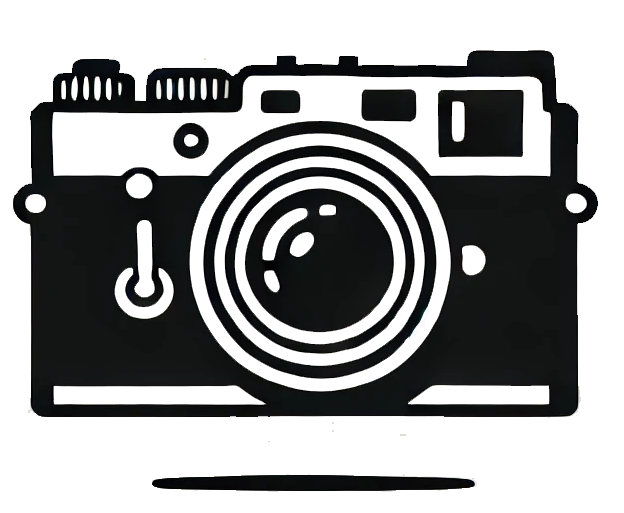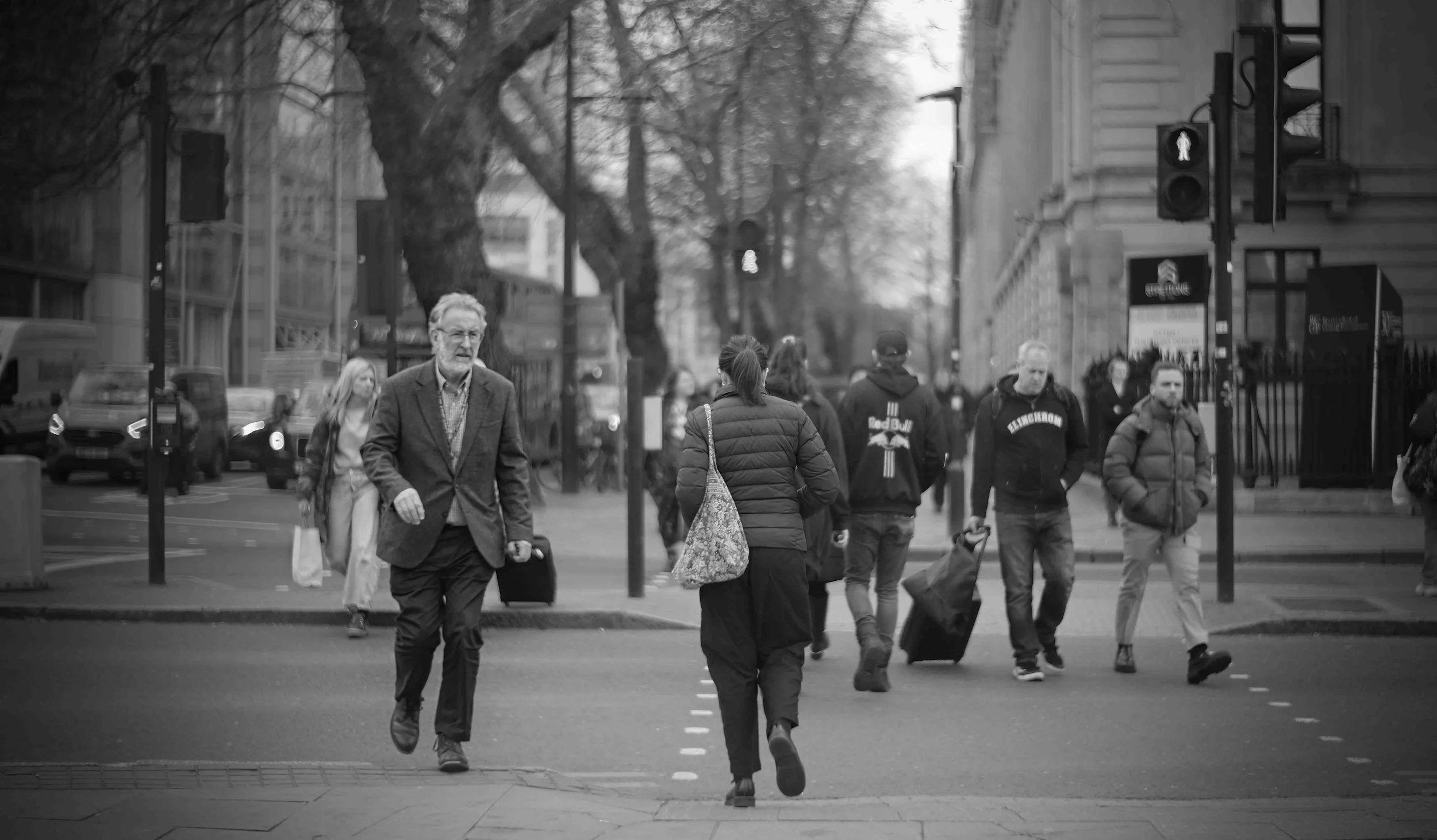Busy Londoners
“The marvels of daily life are exciting; no movie director can arrange the unexpected that you find in the street.”
– Robert Doisneau
Seated in the warmth of Leica Store Mayfair Londoon, the city unfolds through the window—a world in motion, yet framed, distant. A man strides past, his coat slightly billowing, caught mid-step in the rhythm of the urban pulse. He is unaware of the unseen observer behind the glass, sipping coffee, watching stories unfold. The reflections blur the line between inside and out. The soft curve of the Store logo merges with the hard lines of the street, the bicycles, the parked cars, the red-brick buildings standing firm against time. Life continues beyond the frame, yet in this single moment, everything feels still—paused in a perfect composition of movement and stillness. A second later, the door will open, the warmth of coffee will meet the chill of the air, and the separation between these two worlds will fade. But for now, the divide remains—one step away from joining the city’s rhythm.
He moved forward, out of the cavernous embrace of the archway. Behind him, history—brickwork carved with stories of the past. Ahead, glass and concrete, a city still under construction, its future yet to be written. The contrast was stark. The old passage, with its elegant details, stood like a whisper from another time, while the modern façade ahead was rigid, efficient, uniform. Yet the city held them both, layering eras like chapters in a book. Workers moved in the background, assembling something new. A van stood parked, temporary yet essential, part of the city’s endless cycle of change. And in the middle of it all, a lone figure—neither rushing nor hesitating—simply moving forward, bridging the space between what was and what will be.
The air was crisp, the wind teasing at the edges of her trench coat. She walked with purpose, her grip firm on the handle of her bag, dark sunglasses shielding her expression. The cobblestones beneath her feet shimmered in the afternoon light, their uneven surface echoing a time long past. Behind her, history stood tall—the intricate facade of St. Pancras, a reminder of the city's enduring grandeur. In front of her, glass and steel marked the future. She was neither here nor there, a traveler between eras, between moments. Pedestrians passed by, their movements absorbed into the fabric of the street. She paid them no mind. The city was alive, but for now, this path belonged to her alone.
The city has changed, but the rhythm remains the same. The woman strides forward, wrapped in layers against the crisp air. Her posture is steady, her face lined with years of movement, of places seen and passed through. She is neither in a rush nor lingering—just walking, as she always has. The bricks of St. Pancras rise behind her, their Gothic details untouched by time, standing as they have for over a century. The pavement, slick from a recent rain, reflects the arches and the light, creating a distorted mirror of past and present. Ahead, another figure walks away, vanishing into the vastness of the city. Each person, a traveler in their own right. Some on fleeting paths, others on well-worn roads. But in this moment, with the weight of history behind her and the unknown ahead, she simply keeps walking.
The cigarette burned low, its faint glow barely visible against the gray morning. He didn’t rush. The city could wait. The rain had stopped, but the streets were still slick, each puddle carrying a distorted reflection of the skyline. A cab idled beside him, its driver watching the world through fogged-up windows. The cranes in the distance clawed at the sky, an endless construction of something new, something shinier—though he doubted it would ever be for people like him. Behind him, a friend—perhaps just a familiar shadow—walked in step, saying nothing. No words were needed. The city spoke for them: the distant blare of a horn, the muffled chatter of office workers, the rhythmic splash of hurried footsteps. He took another drag. Another minute gone. Then, without a word, he exhaled and walked on.
They didn’t slow down. One spoke with his hands, his words sharp, measured, cutting through the din of the city. The other listened, smoke curling from his cigarette, his grip tightening on the leather handle of his briefcase. A deal, an argument, a strategy—whatever the conversation was, it carried weight, moving as fast as their footsteps. Behind them, the world carried on. A woman in black moved at her own steady rhythm, her gaze lowered, while further back, an older lady adjusted her scarf against the cold. Pedestrians blurred into the background, their own lives threading through the same streets, yet never truly intersecting. But these two men? They walked with purpose. The kind of walk that turns conversations into outcomes. The kind of walk that makes things happen.
The station doors slid open and closed in a constant rhythm, spilling waves of travelers onto the pavement. The world moved fast—people rushing past with backpacks, phones in hand, eyes fixed ahead. No one stopped. But she sang anyway. Her voice cut through the cold air, soft yet persistent. The microphone was his anchor, her jacket zipped tight against the chill, her breath visible between lyrics. A few heads turned, curiosity flickering before fading just as quickly. Coins clinked occasionally into his case, but more often, feet simply passed by. In the blur of movement, in a city too busy to listen, her song became part of the background—a quiet act of resistance against the rush of time.
The wheels of her suitcase hummed softly against the pavement, a familiar sound in a city that thrives on transit. She had just stepped out of the station, the rush of train arrivals and departures fading behind her. The air carried the scent of coffee and distant car fumes, the streetlights beginning to glow as dusk settled over London. She glanced at her phone, a message waiting. Perhaps directions, a welcome, or just another notification lost in the stream of modern life. But for now, she kept walking, rolling her small world beside her, another traveler among many. The streets were alive with movement—hooded figures passing by, a shopper clutching a yellow bag, a bus weaving through evening traffic. The city embraced them all, each on a different path, each carrying their own stories. But in this moment, the story was hers. A quiet journey between destinations, a pause before the next step.
The light changed, and the city moved. An elderly man stepped forward, his face lined with years of experience, his grip firm on the handle of his briefcase. His gaze was steady, focused ahead. Across from him, a woman in a puffer jacket carried a floral bag over her shoulder, her steps brisk but unhurried. Around them, the crowd dispersed like a shifting tide—each person caught in their own unseen urgency. A man in a branded hoodie pulled his bag closer as he weaved through the pedestrians, while another, wrapped in a thick winter coat, adjusted his pace to match the rhythm of the street. For a brief second, their lives intersected—a silent choreography dictated by traffic lights and routine. No words exchanged, no glances held, yet for that instant, they shared the same space, the same city, the same fleeting moment before moving on. The light would change again. The crowd would shift. And just like that, the moment would disappear.
The city never stops. Neither does he. From the moment his polished shoes touched the pavement that morning, he knew where he was headed. The weight of the briefcase in his grip was familiar, its leather worn from years of ambition. The cool air carried the scent of coffee and street food, the hum of conversations blending with distant construction noise. Around him, the city moved—hooded figures drifting toward store entrances, a bronze bull frozen mid-charge, scaffolding promising yet another change to the skyline. But he was undeterred, separate from the currents of distraction. Every step had purpose. Every movement was deliberate. The city belonged to those who walked with intent. And so, he walked.
The morning air carried the hum of the city—cars in the distance, the occasional rustling of leaves, the rhythmic sound of a bicycle chain. The cyclist pedaled forward, sunglasses shielding his eyes, lost in his own momentum. The woman in the beige coat walked briskly, her bag swaying with each step, her thoughts likely elsewhere. Yet, in the center of it all, a presence remained. The glass of the red phone booth, streaked with grime and forgotten calls, held a ghostly figure—a reflection that seemed neither here nor there. Was it someone trapped in memory, a lingering past watching as the world moved on? Or was it just an illusion, a trick of the light, like the city itself—forever changing, yet always the same? A moment passed. The cyclist moved on. The woman disappeared around the corner. The reflection, however, remained.
The city is full of encounters that never happen. The man in the suit walks with an air of quiet confidence, his sunglasses shielding him from the world. The newspaper in his hand crinkles slightly with each step. Beside him, the traveler moves in the opposite direction, their backpack weighed down, their gaze fixed ahead. They pass within inches, yet remain in different worlds. Behind them, London carries on—black cabs crawling through traffic, leafless branches stretching into the sky. The moment lasts no longer than a breath, an unspoken contrast of lives that cross but never connect. And just like that, they’re gone.
Laughter spills into the street as he reads something amusing on his phone. She listens, her eyes reflecting curiosity and delight. They walk in sync, their casual elegance blending into the sophisticated cityscape. Behind them, life continues—strangers lost in their own thoughts, steps, and destinations. The shop signs above hint at luxury, but the real wealth here is in their shared moment, a brief but genuine connection captured in motion. Perhaps it's an inside joke. A funny text. A memory they just recalled. Whatever it is, it lives in the space between them, in the rhythm of their steps and the easy way their bodies lean into conversation. This is city life—not just movement, but moments. And for now, this one belongs to them.
















